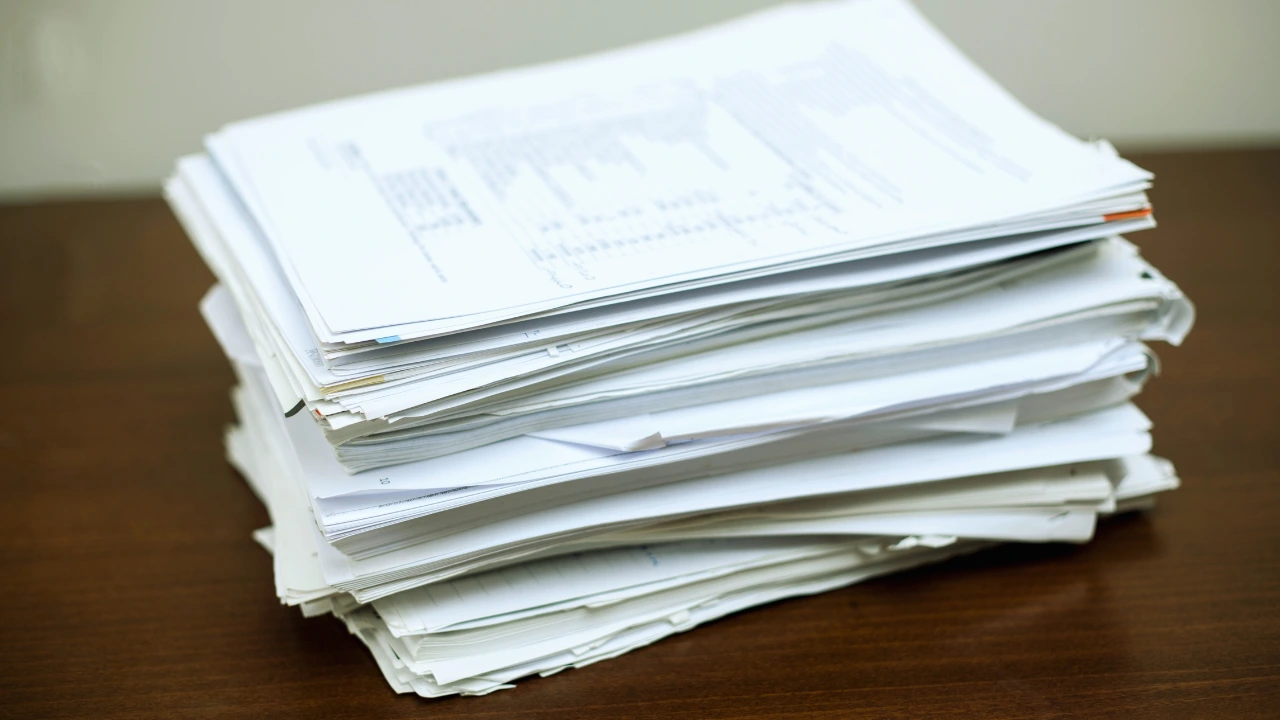Table of Contents
Ever picked up a flyer that felt super flimsy? Or maybe you’ve held a fancy wedding invite that was thick and smooth like a postcard? That’s GSM at work even if you didn’t know it yet.
GSM stands for Grams per Square Meter, and it’s the number that tells you how thick or heavy a sheet of paper is. Sounds boring? Stick with me it actually makes a big difference, especially if you’re printing something important.
Whether you’re buying paper for your printer at home or sending a design to the print shop, knowing a bit about GSM can save you time, money, and a whole lot of confusion.
What Is GSM in Paper?
Alright, so here’s the deal GSM stands for Grams per Square Meter. It’s a measurement of how much a single square meter of paper weighs. Simple as that.
But here’s the trick: even though it’s about weight, GSM also gives you a pretty good idea of the thickness or sturdiness of the paper. The higher the GSM, the heavier and usually thicker the paper feels in your hands.
For example:
-
80 GSM is your basic everyday printer paper light and easy to fold.
-
250 GSM feels more like a postcard sturdy, tough, and not so easy to crumple.
So if you’ve ever wondered why one sheet of paper feels like tissue and another feels like cardboard, now you know: it’s all in the GSM.
Why GSM Matters
GSM might seem like just a number, but it actually plays a big role in how your printed stuff turns out. Here’s why it matters:
1. Feel and Appearance
Higher GSM paper feels more premium. If you’re handing out business cards or wedding invites, thin, floppy paper just won’t cut it. People notice when something feels cheap and they definitely notice when it feels high quality.
2. Durability
Thicker paper (higher GSM) holds up better. So if it’s something that’ll be handled a lot like a restaurant menu or a brochure you’ll want a higher GSM to keep it from bending, tearing, or wearing out quickly.
3. Print Quality
Paper with a decent GSM can hold ink better, especially if you’re printing color. No bleeding, no smudging just clean, crisp prints. Thinner paper can struggle with that.
4. Purpose Fit
Different projects call for different paper types. Flyers, posters, packaging, greeting cards they all need the right GSM to look and perform the way you expect.
Bottom line? GSM helps you pick the right paper for the job, so your design looks great and holds up in real life.
GSM Paper Comparison Chart
Not sure which GSM fits your project? This chart makes it super easy to get a feel for what each range is typically used for no guessing needed:
| GSM | Paper Type | Common Uses |
|---|---|---|
| 60–80 GSM | Thin paper | Office printing, internal documents, notebooks |
| 90–100 GSM | Standard printer paper | Resumes, basic flyers, school projects |
| 120–170 GSM | Mid-weight paper | Posters, brochures, higher-quality flyers |
| 200–250 GSM | Card-like paper | Invitations, magazine covers, menus |
| 300+ GSM | Heavy cardstock | Business cards, postcards, packaging |
Keep in mind: GSM is about weight, but it feels like thickness. So if you’re trying to impress (or just avoid that flimsy-paper look), higher GSM is the way to go.
How to Choose the Right GSM
Picking the right GSM doesn’t have to be confusing. It all boils down to what you need your paper to do and how you want it to feel. Here are some easy tips:
1. Think About Purpose
-
For everyday printing like documents, school papers, or internal memos stick to 80–100 GSM.
-
For flyers or brochures that need to look nice but still be affordable, aim for 120–170 GSM.
-
For invitations, greeting cards, or anything you want to feel special, go for 200+ GSM.
-
Business cards and postcards usually use 300 GSM or more because they need to be sturdy.
2. Consider Handling
Will people be holding or carrying it around a lot? The more handling, the thicker the paper should be to avoid damage.
3. Check Printing Method
Some printers and copiers handle thicker paper better than others. If you’re using a home printer, double-check the max GSM it supports.
4. Budget Matters
Heavier paper costs more so balance quality with how much you want to spend. If it’s a short-term flyer, lighter paper might be just fine.
5. Ask for Samples
If you’re working with a print shop, ask for paper samples or swatches. Feeling the paper in person beats any guesswork.
Common GSM Myths & Mistakes
GSM can be a bit tricky, and lots of people get mixed up about what it actually means. Let’s bust a few myths:
Myth 1: Higher GSM always means thicker paper
Usually true, but not always. Paper texture and coating can affect thickness even if the GSM is the same. So two papers with the same GSM might feel different.
Myth 2: GSM is the same everywhere
Mostly true worldwide, but some countries also use pounds (lb) to measure paper weight. So make sure you’re comparing the same units when shopping internationally.
Myth 3: You need super high GSM for quality
Not necessarily. Sometimes a well-coated or high-quality 120 GSM paper looks and feels better than a cheap 200 GSM sheet.
Myth 4: GSM equals thickness
GSM measures weight, not exact thickness. Thickness is measured in microns or mils, but GSM is a good rough guide.
GSM vs. Other Paper Measurements
If you’ve shopped for paper, you might have seen other terms like pounds (lb) or points (pt) thrown around. Here’s how GSM stacks up:
Pounds (lb)
-
Mostly used in the U.S. and Canada.
-
Pounds measure the weight of a ream (500 sheets) of paper in a specific size.
-
It can get confusing because the size of the paper varies (like letter size vs. tabloid).
-
Rough rule: 80 GSM is about 20 lb in typical office paper.
Points (pt)
-
Points measure the thickness of cardstock and cover stock.
-
1 point = 1/1000th of an inch.
-
Used mostly for business cards or packaging.
-
Example: 12 pt cardstock is roughly equivalent to 300 GSM.
Why GSM is Easier
GSM is a simple, consistent metric measurement the weight of one square meter of paper, no matter the size or type. That makes it easier to compare papers globally.
Tips for Buying the Right Paper
Buying paper might sound straightforward, but a few simple pointers can make your life easier and save you from surprises:
1. Know Your Project
Be clear about what you need the paper for flyers, business cards, photos, or everyday printing. That’ll help you focus on the right GSM range.
2. Ask for Samples
If you’re working with a print shop or buying in bulk, ask for paper samples or swatches. Feeling the texture and weight in person beats guessing online.
3. Check Printer Compatibility
Make sure your printer or the printing service can handle the GSM you want. Some home printers struggle with anything over 120 GSM.
4. Consider Finish and Coating
Glossy, matte, textured the finish can affect the look and feel as much as GSM. Ask about coatings if you want your prints to pop or last longer.
5. Set a Budget
Higher GSM usually costs more. Balance quality with cost, especially if you’re printing a lot. For short-term use, lighter paper might be enough.
6. Don’t Skip Research
Look up reviews or get advice from printing pros. They can often recommend the best GSM for your specific needs.
Conclusion
GSM in paper might sound like a technical term, but it’s really just a handy way to understand how thick or heavy your paper is. Knowing what GSM means helps you pick the right paper for whatever project you’re working on whether it’s everyday printing, fancy invitations, or business cards that need to stand out.
Remember: higher GSM means sturdier, heavier paper, but it’s not the only thing that matters. Consider your project’s purpose, how much handling the paper will get, and your budget. And don’t hesitate to ask for samples or advice it makes a big difference.



Great breakdown of GSM! It’s super helpful for anyone choosing paper for printing or design projects. Understanding GSM really makes a difference in quality, durability, and choosing the right paper for the job. Clear and practical guide!